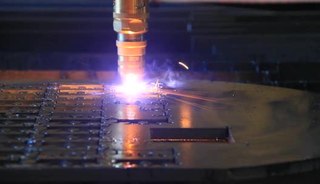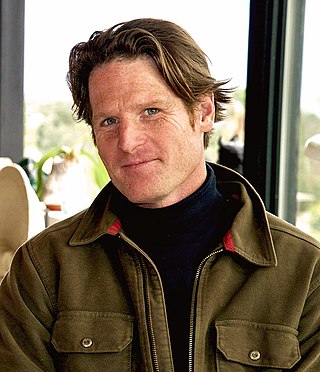A game engine is a software framework primarily designed for the development of video games and generally includes relevant libraries and support programs. The "engine" terminology is similar to the term "software engine" used in the software industry.

Alexander Calder was an American sculptor known both for his innovative mobiles that embrace chance in their aesthetic, his static "stabiles", and his monumental public sculptures. Calder preferred not to analyze his work, saying, "Theories may be all very well for the artist himself, but they shouldn't be broadcast to other people."

Metalworking is the process of shaping and reshaping metals to create useful objects, parts, assemblies, and large scale structures. As a term it covers a wide and diverse range of processes, skills, and tools for producing objects on every scale: from huge ships, buildings, and bridges down to precise engine parts and delicate jewelry.

An anvil is a metalworking tool consisting of a large block of metal, with a flattened top surface, upon which another object is struck.

The Angel of the North is a contemporary sculpture by Antony Gormley, located in Gateshead, Tyne and Wear, England. Completed in 1998, it is believed to be the largest sculpture of an angel in the world and is viewed by an estimated 33 million people every year due to its proximity to the A1 and A167 roads and the East Coast Main Line. The design of the Angel, like many of Gormley's works, is based on Gormley's own body. The COR-TEN weathering steel material gives the sculpture its distinctive rusty, oxidised colour. It stands 20 metres (66 ft) tall with a wingspan of 54 metres (177 ft), larger than that of a Boeing 757 aircraft. The vertical ribs on its body and wings act as an external skeleton which direct oncoming wind to the sculpture's foundations, allowing it to withstand wind speeds of over 100 miles per hour (160 km/h).

A curtain wall is an outer covering of a building in which the outer walls are non-structural, designed only to keep the weather out and the people in. Because the curtain wall façade carries no structural load beyond its own dead load weight, it can be made of lightweight materials. The wall transfers lateral wind loads upon it to the main building structure through connections at floors or columns of the building.
Prefabrication is the practice of assembling components of a structure in a factory or other manufacturing site, and transporting complete assemblies or sub-assemblies to the construction site where the structure is to be located. Some researchers refer it to “various materials joined together to form a component of the final installation procedure“. The most commonly cited definition is by Goodier and Gibb in 2007, which described the process of manufacturing and preassembly of a certain number of building components, modules, and elements before their shipment and installation on construction sites.

Metal fabrication is the creation of metal structures by cutting, bending and assembling processes. It is a value-added process involving the creation of machines, parts, and structures from various raw materials.

Plasma cutting is a process that cuts through electrically conductive materials by means of an accelerated jet of hot plasma. Typical materials cut with a plasma torch include steel, stainless steel, aluminum, brass and copper, although other conductive metals may be cut as well. Plasma cutting is often used in fabrication shops, automotive repair and restoration, industrial construction, and salvage and scrapping operations. Due to the high speed and precision cuts combined with low cost, plasma cutting sees widespread use from large-scale industrial computer numerical control (CNC) applications down to small hobbyist shops.

Jean Prouvé was a French metal worker, self-taught architect and designer. Le Corbusier designated Prouvé a constructeur, blending architecture and engineering. Prouvé's main achievement was transferring manufacturing technology from industry to architecture, without losing aesthetic qualities. His design skills were not limited to one discipline. During his career Jean Prouvé was involved in architectural design, industrial design, structural design and furniture design.

IMCO Carbide Tool is an American manufacturing company that researches, designs and manufactures high-performance cutting tools for a variety of applications in the aerospace, automotive, medical, petrochemical, and manufacturing industries. Founded in 1977 by Lawrence R. Osburn and headquartered in Perrysburg Twp, Ohio, IMCO serves a diverse customer base of small job shops to large production operations around the world.
Specimen Products is a Chicago-based manufacturer of custom guitars, tube amplifiers, and audio horn speakers led by luthier Ian Schneller. Specimen Products also offers courses in guitar and tube amplifier design, construction, and repair through their Chicago School of Guitar Making. The Specimen workshop offers repair services to the general public, making use of their collection of parts from rare and vintage manufacturers.

Intonarumori are experimental musical instruments invented and built by the Italian futurist Luigi Russolo between roughly 1910 and 1930. There were 27 varieties of intonarumori built in total, with different names.

The maker culture is a contemporary subculture representing a technology-based extension of DIY culture that intersects with hardware-oriented parts of hacker culture and revels in the creation of new devices as well as tinkering with existing ones. The maker culture in general supports open-source hardware. Typical interests enjoyed by the maker culture include engineering-oriented pursuits such as electronics, robotics, 3-D printing, and the use of computer numeric control tools, as well as more traditional activities such as metalworking, woodworking, and, mainly, its predecessor, traditional arts and crafts.

Matt Hope is a British artist who lives and works in Caochangdi, an arts district in Beijing, China. He is known for elaborate kinetic art and sound art constructions made in large-scale fabrication factories in Mainland China.

A mount maker is responsible for the creation of structures called object mounts used to provide unobtrusive physical support, stability, and security of objects while on display, in storage, or being transported to museums, art galleries, libraries, archives, botanical gardens or other cultural institutions. Protection and long-term conservation of the object is a key goal of mount makers. This is accomplished through careful design, selection of materials and manufacturing process that will not inadvertently harm the object, and a cautious installation process of the object into its place in an exhibit. Professionals in this field can be employed directly by an institution, be independent contractors, or work as part of larger cultural institution exhibit design firms.

Artisans Asylum is a non-profit community workshop in Allston, Massachusetts. Artisans Asylum was founded in 2010 by an engineer, an artist, and friends who needed an affordable place to build and make things. Artisans was the first makerspace to incorporate in the U.S. in 2012 and today is 40,000 square feet of fabrication space.
Scrap Arts Music is a percussion-based, performing arts company headquartered in British Columbia, Canada, founded by Canadian artists, Gregory Kozak and Justine Murdy, in Vancouver, in July 1998. Scrap Arts Music creates original instruments and musical compositions; produces original sound and video recordings; and creates choreographed athletic performances for theatres, festivals, schools, orchestras, and special events.
Carlson Baker Arts is an American company that provides custom fabrication and engineering services to artists, architectural firms and commercial companies. Based in Sun Valley, California, the company is most known for its work for artists such as Ellsworth Kelly, Jeff Koons, Christian Moeller, Isamu Noguchi, and Claes Oldenburg / Coosje van Bruggen, among others. The firm was founded by Peter Carlson in 1971, and has been headed by Carlson and John Baker as partners since mid-2010. Fabricators like Carlson Baker assist in producing technically challenging, large-scale industrial, labor-intensive, or otherwise complex artworks beyond the capacities of artists and companies. Their technical services may range from 3D scanning and modeling to advanced machining, milling, and finishing to assembly, shipping, and installation. Art writers describe the company as one of the field's pioneering and leading fabricators; in 2007, when Artforum gathered a roundtable to discuss the history and growth of art fabrication, it included Carlson and his partner of the time, Ed Suman, as leaders who had "helped realize some of the most technologically ambitious artworks" of the time. Art historian Michelle Kuo described the company as embodying "a growing convergence of artisanal craft, the factory model of production, and the organizational services and informatics that bind these elements together." Specific projects that Carlson Baker has fabricated include: Koons's Balloon Dog series (1996–2010); public sculptures by Oldenburg and van Bruggen, Moeller, and Tony Tasset ; and Kelly's "Panel" and "Totem" series.

Robert William Smart is an American artist whose work spans numerous disciplines from social commentary to programmable lighting technologies. Primarily, his work consists of large-scale Public Art installations in metal and glass for various cities and universities. Smart has been working as an independent artist for the last 30 years and attended many national and international artist-in- residence programs. In addition, he taught sculpture and drawing for various colleges and universities.















